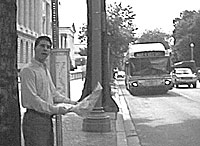|
|
by Tom Valtin and Brian Vanneman
Metro Bus Blues | Zucchini Alert! | Rock 'n Roll, 'n Renewable Energy! | Shasta Fundraiser | Green Test Drive | In Memory
Metro Bus Blues
 |
| Dennis Jaffe, crusader for better transit information in D.C.., reads a
soon-to-be-free system map as a bus pulls up.
|
Last summer, Sierra Club member Dennis Jaffe decided he'd ride the
morning bus to his new job in the Capitol Hill area of Washington, D.C.
Only problem was, he couldn't figure out which bus to take. There were
no maps at the local bus stops, and scant out-of-date information posted
there.
Phone calls to Metrobus, the D.C.-area transportation authority,
yielded only frustration, and the recommendation that he travel to one
of three distant locations where bus maps were for sale for $1.50.
"I thought, 'Gee, if it's difficult for me to figure out this
information, it must be difficult for others,'" he says.
Jaffe spent the next year lobbying Metrobus to provide free, widely
available system maps – like the huge majority of bus agencies – and
guarantee that those maps would also be posted at bus stops and online.
Early this year, the Sierra Club's Washington, D.C., Chapter endorsed
Jaffe's ideas and appointed him its bus information representative.
After being stonewalled for months, Metrobus finally agreed to make free
maps available by January.
But Jaffe hopes that this is just the beginning. He envisions a system
that is convenient, easy to understand, widely used, and helps limit
sprawl and pollution. That may take more than free maps.
Zucchini Alert! Quick, Lock the Car.
In 2001, the Nebraska Chapter hired Laura Krebsbach to educate citizens
about the dangers of pollution from industrial-scale meat factories, and
organize them to stop new facilities. Initially she was rebuffed and
told, "we don't want the Sierra Club."
But she persevered and has since
built an extensive network of volunteers who are writing letters,
jamming public meetings, and working with her to stop factory farm
pollution. Now, when someone catches wind of a proposed facility, they
call the Club. "We've gone from being the pariah to being the first
place rural Nebraskans call for help," Krebsbach says.
The attitude towards the Sierra Club has changed so much that Krebsbach
says she has to lock her car when she travels the state. Otherwise, her
"farm women" hunt her down and secretly fill her car with vegetables.
Rock 'n Roll, 'n Renewable Energy!
 |
| Perry Farrell, front man for the band Jane's
Addiction, poses with Sierra Student Coalition director Meighan Davis,
left, and the SSC's Crystal Durham.
|
While most of their peers were packing up their dorm rooms and heading
to summer rock concerts, Meighan Davis, director of the Sierra Student
Coalition (SSC), was, well, packing up for rock concerts. Not just any
concerts – the SSC had tickets to Lollapalooza, the traveling alternative
music festival that in the '90s took the Woodstock concept and added
mohawks and tattoos.
Davis and Billy Grayson, national conservation organizer in the Club's
Washington, D.C., office, drove to the shows in a rented hybrid car and
set up Sierra Club information centers, where they discussed
environmental issues and encouraged concert-goers to get active. Davis,
Grayson, and their team also persuaded a bunch of rock and rap
performers to visit the tent.
Perry Farrell, pictured above hanging out
with the SSC crew, is Lollapalooza's founder, front man of the band
Jane's Addiction, and a big part of the reason the Club was involved in
the festival. He's made sure that the importance of alternative energy
sources and other progressive causes are communicated to the audience,
with a large area for groups to table outside the concerts. "We're in
danger of losing every environmental law written in this country," said
Farrell, "and the voice that reaches out furthest to people is a musical
one."
Now back in D.C., Davis bemoans that, "my rock star lifestyle has
ended." But she helped sign up a record number of new college-age Club
volunteers – more than 1,000 – and averaged more than 45 mpg in the rented
hybrid.
Shasta Fundraiser
To heighten breast cancer awareness and raise funds for treatment and
research, 49 women and men from all over the country embarked on a mid-
July ascent of California's Mt. Shasta. Base camp for the expedition was
the The Sierra Club Foundation's hut on the mountain's south flank.
Sixteen climbers made it to the summit of the 14,162-foot volcano, but
according to trip participant Nancy Swift, "everybody made a summit."
Swift was joined on the climb by her sister Hilary and her mother, Judy
Guggenhime, one of the many breast cancer survivors participating. a
breast cancer survivor. Breast cancer survivor Jenny Coyle, former
Planet senior editor and now a member of the Club's Web team in San
Francisco, was also among the climbers. The event garnered more than
$600,000.
Green Test Drive
On July 31, the city of Columbia, Missouri, announced that it is getting
on board the clean-air train by including a hybrid car in this year's
budget; two more will join the city fleet next year. Chris Hayday, a
local Sierra Club member, has been promoting hybrids by driving his own
around town.
In Memory
Richard Coleman, a founder of the Club's Florida Chapter, died on July
18 in a head-on airboat collision in central Florida. A retired chemist
for the federal government, Coleman was a passionate outdoorsman and
protector of Florida's natural ecosystems.
He headed up the Club's
Kissimmee River Restoration Committee, and for nearly 20 years led the
fight to restore the natural contours of the 103-mile meandering
waterway, which the Army Corps of Engineers had turned into a straight
56-mile drainage ditch. Coleman's wife Frances says he was taking
photographs of the Kissimmee River Valley the day he died. He was 59.
Up to Top
|